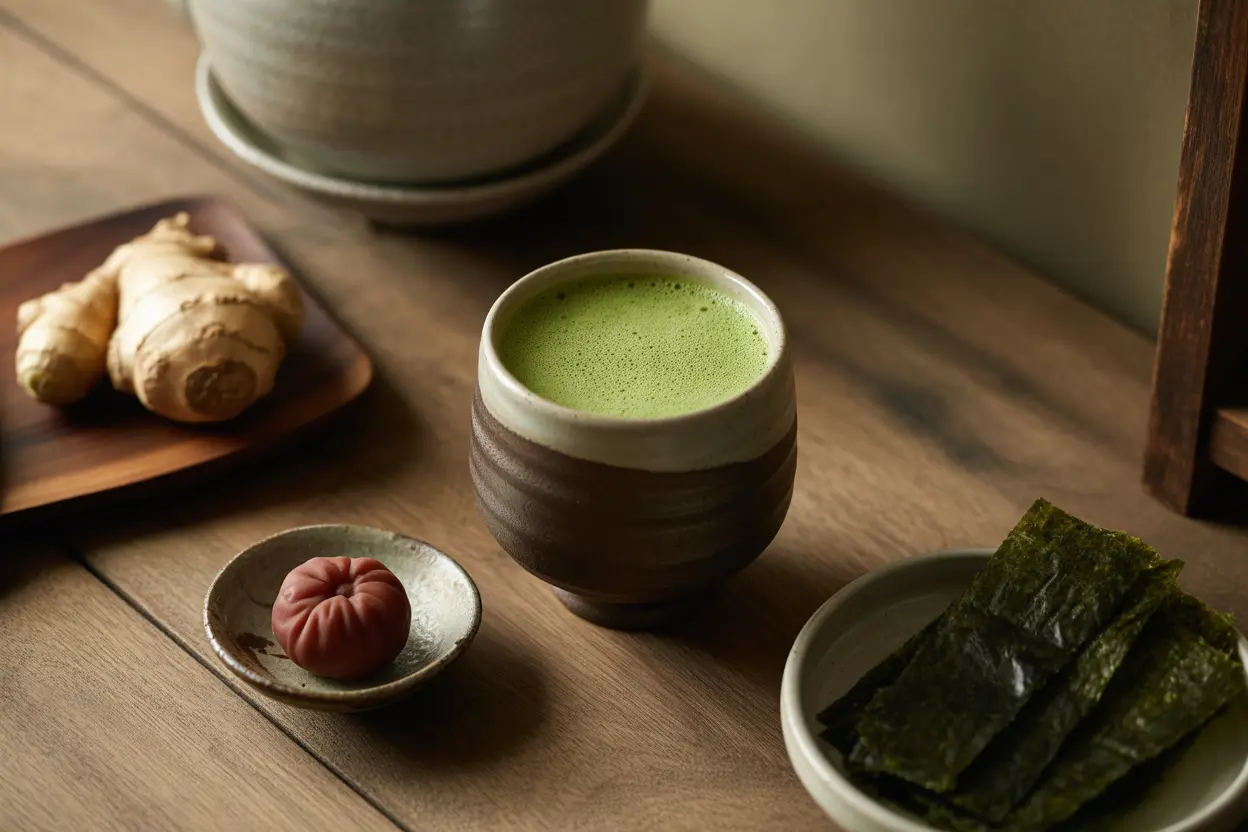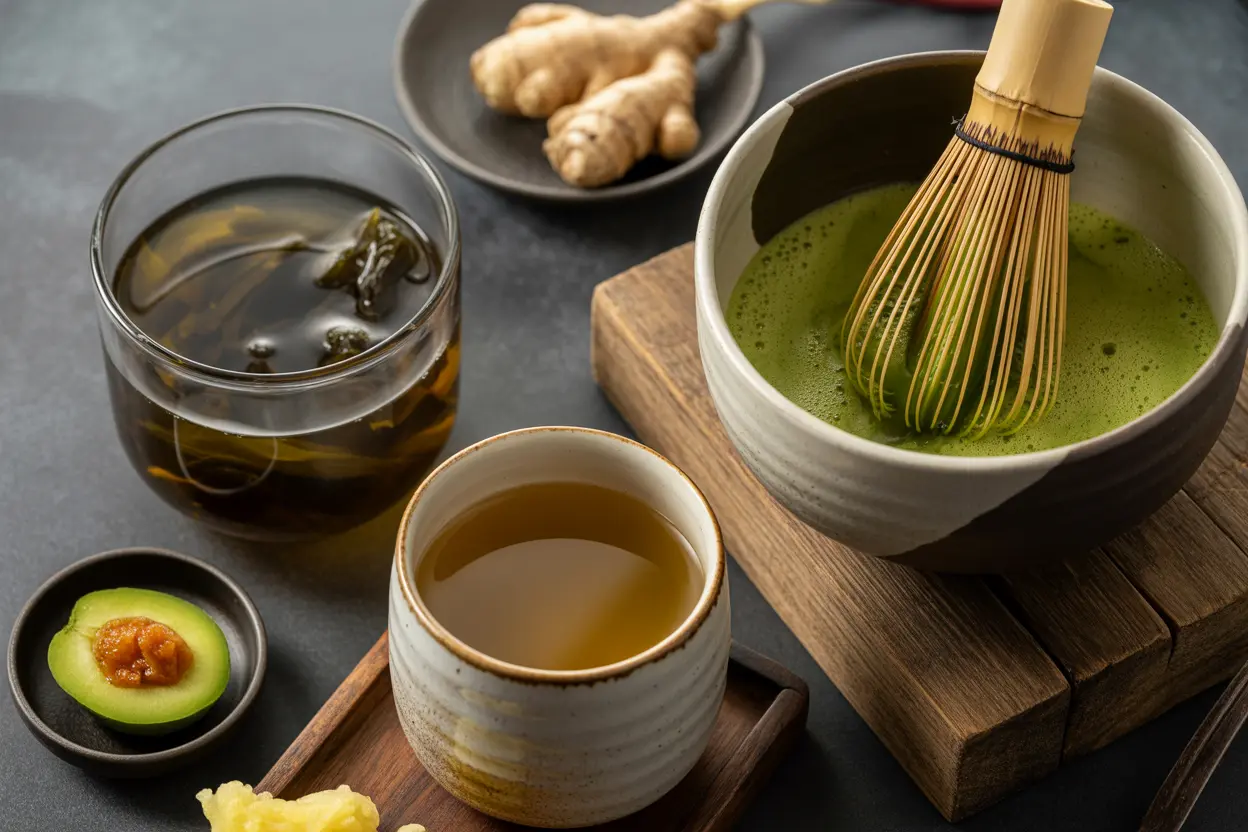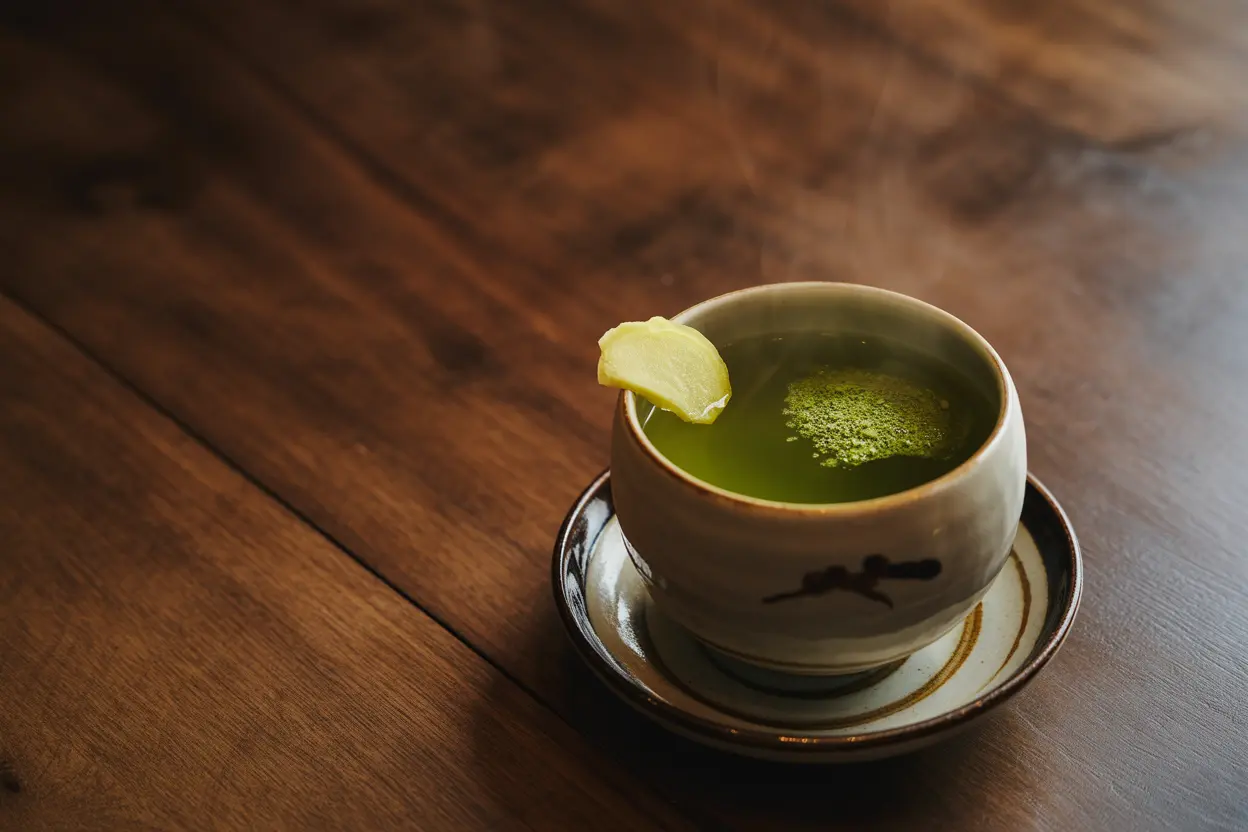Introduction to Japanese Mounjaro
What is Japanese Mounjaro?
Have you ever wondered what makes the Japanese Mounjaro recipe a staple in natural wellness? This traditional Japanese detox drink combines potent ingredients like matcha green tea, umeboshi plum, fresh ginger, and kombu seaweed to craft a beverage that supports digestion and promotes weight loss. More than just a drink, it’s a ritual wrapped in centuries of heritage, designed to nurture your metabolism and gut health. If you want to unlock how to make Japanese Mounjaro at home, you’re in the right place. Curious about the science behind its benefits? Check out the health benefits of matcha green tea and discover what makes this drink a holistic treasure.

Historical and Cultural Context
Steeped in Japanese tradition, the Japanese Mounjaro recipe traces back to wellness rituals emphasizing balance and harmony. These natural ingredients were once treasured by Japanese herbalists for their metabolism boost and probiotic benefits, linking this drink to broader Japanese diet practices centered on longevity and vitality. This beverage reflects not only a way to harness nature’s powers but also a cultural reverence for food as medicine. To dive deeper into similar traditions, you might enjoy a step-by-step guide on making sandwiches as an example of how Japanese and global cuisines celebrate thoughtful preparation.
Key Ingredients of the Japanese Mounjaro Recipe
If you want to discover the traditional wellness beverage that is Japanese Mounjaro, understanding its key ingredients is crucial. Each component contributes unique properties that blend into a health-enhancing drink.
Matcha Green Tea: Benefits and Quality Tips
Matcha green tea is famed for its robust antioxidant profile, offering more concentrated benefits than regular green tea. Its antioxidants in matcha help fight free radicals, supporting overall health and thyroid support. For the best experience, choose ceremonial-grade matcha powder—bright green, finely ground, and fresh. Proper preparation enhances its vibrant flavor and nutrient availability; you can learn more on how to brew matcha properly. Matcha also acts as a gentle natural metabolism booster, making it a cornerstone of the Japanese Mounjaro recipe.
Umeboshi Plum: A Unique Fermented Ingredient
The wildly tangy and salty umeboshi plum is a fermented superfood treasured in Japan for its probiotic benefits and digestive kick. This tiny plum supports digestive health by balancing gut flora and has antioxidant properties that complement matcha’s effects. Its acidity also aids in appetite control and detoxification. For nutritional insights, explore the nutritional benefits of umeboshi plums that outline its role in traditional Japanese cuisine.
Fresh Ginger: Digestive and Thermogenic Properties
Fresh ginger root is a powerhouse of thermogenic ingredients that naturally increase body heat and boost metabolism. Beyond its spicy zing, ginger improves blood flow, eases nausea, and soothes the digestive tract. Its anti-inflammatory properties play a significant role in supporting gut health. For detailed info, the digestive health benefits of ginger explain how it complements the restorative nature of the Japanese Mounjaro recipe.
Kombu Seaweed: Mineral Richness and Preparation
Finally, kombu seaweed rounds out the recipe with a mineral-rich profile, including iodine, calcium, and iron, essential for metabolism and hormonal balance. This edible kelp also supports alkalizing foods in the diet, promoting body pH balance. Proper soaking and gentle simmering release its umami flavor and nutrients efficiently. For preparation tips and health properties, don’t miss the nutritional advantages of kombu seaweed. These traditional Japanese seaweed recipes are an art form themselves!

Step-by-Step Preparation of Japanese Mounjaro
To master the Japanese Mounjaro recipe, follow these easy steps and bring ancient wisdom to your kitchen.
Preparing Kombu Infused Water
Start by gently soaking a strip of kombu seaweed in cold water for about 20 minutes to extract minerals without losing flavor. Avoid boiling to preserve delicate nutrients and avoid bitterness. This mineral-rich kombu water forms the base of your drink, infusing it with natural umami and health benefits.
Whisking Matcha Powder Perfectly
Next, sift 1–2 teaspoons of matcha powder into a bowl. Add a small amount of hot water (around 80°C or 176°F, not boiling) to preserve antioxidant potency. Using a bamboo whisk or electric frother, whisk vigorously in a zigzag motion until you get a frothy, smooth green tea paste free of clumps. This technique unlocks the full flavor and matcha antioxidant properties.
Combining Umeboshi and Ginger
Muddle or finely chop one umeboshi plum and a small knob of fresh ginger root, about 1 teaspoon, to release their flavors. The blend adds a unique sweet-sour-spicy tang and digestive support to the drink. Mixing these fresh ingredients balances the mellow bitterness of the matcha and mineral umami from kombu.
Mixing and Serving the Drink
Pour the kombu infusion into the whisked matcha. Stir in the umeboshi and ginger mixture. Serve warm or chilled, depending on your preference. Garnish lightly with a thin slice of ginger or a sprinkle of matcha powder for an eye-catching finish. Enjoy your cup of natural weight loss drinks brilliance!

Health Benefits of Japanese Mounjaro
Regularly drinking Japanese Mounjaro isn’t just comforting — it’s a one-way ticket to wellness.
Metabolism and Weight Management Support
The combined thermogenic effects of ginger root and matcha green tea support calorie burning and appetite control. These ingredients stimulate your metabolic rate naturally, assisting in healthy weight management tea routines without harsh stimulants. The alkalizing properties of kombu seaweed balance pH, further aiding metabolism and thyroid function.
Digestive Health and Gut Support
Umeboshi plum and ginger provide potent support for digestive health by promoting good gut bacteria and easing inflammation. This synergy helps soothe the stomach, reduce bloating, and improve nutrient absorption, making Japanese Mounjaro a gentle digestive tonic.
Antioxidants and Immune Boosting Properties
Matcha’s rich antioxidants work alongside fermented foods compounds in umeboshi to neutralize free radicals, enhancing your immune system. This potent combo fosters cell repair and overall vitality — a true plant-based wellness powerhouse you can sip daily. For more insights, you might check the natural weight loss guide on incorporating such beverages.
Variations and Optional Ingredients
Exploring variations is part of the joy of making your own Japanese Mounjaro recipe. Let’s see how you can twist it up.
Alternative Ingredients for Umeboshi Plum
If umeboshi plum isn’t available, try substituting with ume plum vinegar or pickled plums to retain that signature tang and ferment benefits. These alternatives deliver similar probiotic and flavor impact, keeping your drink authentic yet accessible.
Additional Flavor Boosters: Lemon, Yuzu, and Honey
Want to brighten the taste? Adding a splash of fresh lemon juice or a few strips of yuzu zest enhances citrus notes while supporting digestion. For natural sweetness and further probiotic support, a teaspoon of raw honey for health can mellow the drink beautifully. These extras lift your drink into a uniquely refreshing experience.
Innovative Twists: Miso, Turmeric, and Konjac Powder
For adventurous palates, blending in a touch of miso paste adds savory depth and probiotics, turmeric brings anti-inflammatory power, and konjac powder offers fiber for satiety. These ingredients modernize your drink while honoring traditional Japanese wellness principles. For similar inspiration, see classic recipes and tips for French sandwiches.
Tips for Best Experience and Usage
To truly savor the benefits of Japanese Mounjaro, here are some handy usage tips.
Optimal Times to Consume Japanese Mounjaro
Drinking Japanese Mounjaro first thing in the morning jumpstarts your metabolism and cleanses the digestive tract. It also works well before meals to support digestion and control appetite, or during an afternoon slump for a gentle energy lift.
Water Temperature and Ingredient Quality
Use filtered water at around 80°C (176°F) to maximize nutrient extraction without damaging delicate compounds, especially in matcha green tea. Always choose fresh, organic ingredients when possible to enhance flavor and health effects.
Storage and Serving Suggestions
Best enjoyed fresh, but if needed, store your drink in a sealed container in the fridge for up to 24 hours. Gently reheat before serving or enjoy cold for a refreshing twist. Experiment with serving sizes and ingredient ratios to find your perfect balance. For more homemade drink preparation techniques, explore additional tips here.
Frequently Asked Questions about Japanese Mounjaro
What is the Japanese Mounjaro recipe and what are its main ingredients?
The Japanese Mounjaro recipe is a traditional wellness drink combining matcha green tea, umeboshi plum, kombu seaweed, and fresh ginger. It is crafted to support digestion, boost metabolism, and aid weight management. Each ingredient offers unique health benefits, from antioxidants to digestive enzymes, making the drink a comprehensive natural remedy inspired by Japanese herbal practices.
How does Japanese Mounjaro support weight loss and digestion?
This drink harnesses thermogenic ingredients like ginger and matcha to naturally increase calorie burn. The fermented umeboshi plum promotes gut health and digestion, while kombu contributes essential minerals and alkalizing effects. Together, these components help regulate appetite, improve metabolism, and soothe the digestive system, forming a holistic approach to weight management.
Can I substitute umeboshi plum in the recipe?
Yes, substitutions like ume plum vinegar or pickled plums can replicate the tangy, fermented flavor of umeboshi. These alternatives maintain the probiotic and digestive support qualities essential to the drink’s effectiveness, though the flavor nuances may slightly vary.
What is the best way to prepare matcha for Japanese Mounjaro?
Use ceremonial-grade, finely sifted matcha powder. Add hot (not boiling) water around 80°C, then whisk swiftly in a zigzag motion with a bamboo whisk or frother to create a smooth, frothy consistency. This method preserves matcha’s antioxidant properties and ensures a vibrant, delicious flavor.
Are there any variations or added ingredients I can try?
Absolutely! You can enhance the drink with lemon juice, yuzu zest, or raw honey for sweetness. For a savory twist, add a bit of miso paste, or boost anti-inflammatory benefits with turmeric. Konjac powder also adds fiber for satiety. These options allow customization while preserving the drink’s traditional health benefits.
The Japanese Mounjaro recipe blends traditional Japanese ingredients like matcha, umeboshi plum, kombu seaweed, and fresh ginger into a natural wellness drink that supports digestion, metabolism, and weight management. Preparing this drink with care and enjoying it regularly can be a beneficial addition to a healthy lifestyle. Experimenting with optional ingredients like lemon, honey, or yuzu peel can personalize the experience. Always use quality ingredients and optimal water temperature to maximize the health benefits. Incorporating Japanese Mounjaro into your routine offers a delicious, soothing, and effective natural remedy drawn from age-old Japanese wellness traditions.
